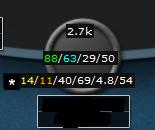Member Comments
No comments so far
 In the second installment of our series on stats in Heads-Up Displays (HUDs), we'll be talking about the second half of the "big two." While Voluntarily Put Money into the Pot (VP) tells you how often your opponents put money in pre-flop – an excellent indicator as to how tight or loose they might be – its little brother Pre-Flop Raise (PFR) helps you get a real understanding of their pre-flop play. If you haven’t already, read our VP breakdown.
In the second installment of our series on stats in Heads-Up Displays (HUDs), we'll be talking about the second half of the "big two." While Voluntarily Put Money into the Pot (VP) tells you how often your opponents put money in pre-flop – an excellent indicator as to how tight or loose they might be – its little brother Pre-Flop Raise (PFR) helps you get a real understanding of their pre-flop play. If you haven’t already, read our VP breakdown.
Without knowing how aggressive your opponent is, you can't get a very good feel for their hand range, and with the importance of 3betting in today's aggressive game, you will have trouble being a big winner without understanding your opponent's pre-flop raising range. PFR is measured any time there has been no raise and a player chooses to raise. Whether it is a minimum raise or an all-in push, the PFR stat will be incremented. PFR is useful to most players in two ways.
Estimating Your Opponent's Range
If you know how often a player raises pre-flop, by subtraction you will know how often they limp. If we take an example player with a VP: 26 and PFR: 12 – expressed in shorthand as 26/12 – and look at his likely ranges, we can get a pretty good estimate.
In late-middle position, this player's stats will probably be indicative of his real ranges, so we'll assume that he is in the hijack seat. These stats indicate that this player will play the top 26% of all hands, but he will only raise with the top 12%. This means that when he limps into the pot or calls a raise, he will have a range that is approximately from the 26th to the 12th percentile. I use this list to turn percentages into ranges.
PokerStove is a good way to find ranges and a number of poker calculators have range finders built in. By looking at a list of hands based on strength and how the average poker player sees them, we can guess that his playing range of 26% is approximately:
22+, A2+, KT+, QTs+
His raising range of 12% is much tighter, including hands like:
22+, A9s+, ATo+, KQ
When this player limps along behind other limpers, you can assume that he usually will have a hand in the range between the two. Hands like lower Broadway cards, smaller suited aces, and in some cases suited connectors instead of weaker aces will be his primary limping range.
Aggression Indication
The way your opponent plays pre-flop can help you get a feel for their whole approach to the game. As an example, in a ten-handed No Limit game, your PFR stat should be around two-thirds of your VP. As we know from our previous article, the correct VP is between 15% and 20%, so correct PFR numbers are anywhere from 10% to 13.5%. But, a 20/10 player and a 15/13 player are very different people even though both technically fit within the range of stats we think of as correct.
The 20/10 player is too passive pre-flop. He probably calls a few too many raises when the situation isn't as good as he thinks it is and he may limp along too often as well. Knowing that he is passive pre-flop, we can guess that he likes to see flops and may be hoping to hit a monster. Making a standard bet on the flop should chase him out of most pots and since he is a passive player, you will not have a lot of trouble playing against him.
The 15/13 player is raising nearly every hand he plays. Because many hands are already raised when they get to him, he probably has a high 3bet number in order to maintain that 13% PFR. It's also possible that he simply never open-limps and never limps along behind other players. If he also only very rarely calls raises and usually folds or 3bets, then his 3bet percentage may be reasonable and he just isn't interested in seeing a flop. This may be a frustrating player to deal with, but he is susceptible to a few plays, like the limp-re-raise or the light 3bet.
If you've played enough poker, then you probably have a feel for how the two players above might see the game. After the flop, you can expect their tendencies to remain the same, with the passive player happy to see the next card cheaply most of the time and the aggressive player tending to bet, raise, check-raise, or fold rather than checking or calling. This will result in a high post-flop Aggression Factor.
Now that you have an understanding of VP and PFR, you can see how they relate to each other and start building a profile of an opponent just from the first two stats in your HUD.
No comments so far